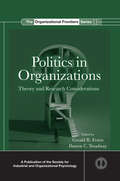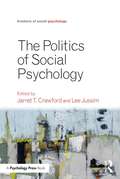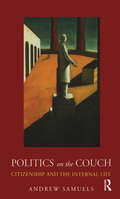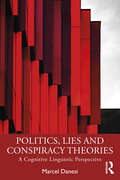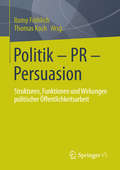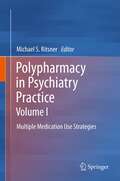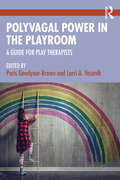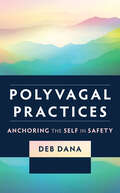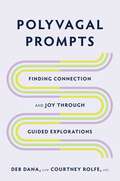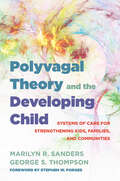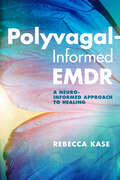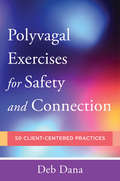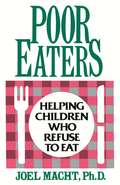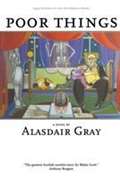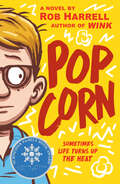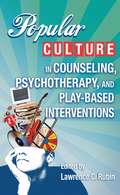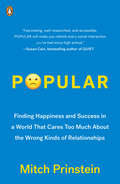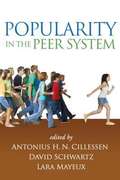- Table View
- List View
Politics in Organizations: Theory and Research Considerations (SIOP Organizational Frontiers Series)
by Gerald R. Ferris Darren C. TreadwayThis edited volume in the SIOP Frontiers series is one of the first to look at the psychological factors behind politics and power in organizations. Noted contributors from schools of management, psychology, sociology and political science look at the theory, research, methodology and ethical issues related to organizational politics and climates. The book is divided into three parts: Part 1 looks at the historical evolution of the field; Part 2 integrates organizational politics with important organizational behavior constructs and/or areas of inquiry, for example in the chapter by Lisa Leslie and Michele Gelfand which discusses the implications of cross-cultural politics on expatriates and within cross-national mergers; and Part 3 focuses on individual differences and organizational politics, focusing on the nature of political relationships.
Politics of Social Psychology (Frontiers of Social Psychology)
by Lee Jussim Jarret T. CrawfordSocial scientists have long known that political beliefs bias the way they think about, understand, and interpret the world around them. In this volume, scholars from social psychology and related fields explore the ways in which social scientists themselves have allowed their own political biases to influence their research. These biases may influence the development of research hypotheses, the design of studies and methods and materials chosen to test hypotheses, decisions to publish or not publish results based on their consistency with one’s prior political beliefs, and how results are described and dissemination to the popular press. The fact that these processes occur within academic disciplines, such as social psychology, that strongly skew to the political left compounds the problem. Contributors to this volume not only identify and document the ways that social psychologists’ political beliefs can and have influenced research, but also offer solutions towards a more depoliticized social psychology that can become a model for discourse across the social sciences.
Politics on the Couch: Citizenship and the Internal Life
by Andrew SamuelsThis is an accessible, lucid and stimulating account of the hidden psychology of politics and the hidden politics of the psyche. It is packed with original and imaginative ideas on economics, nationalism, "good-enough" leadership, the citizen and the state, women and men, fatherhood, and the citizen as a "therapist of the world". The author offers trenchant and timely critiques of the crisis in contemporary politics. The book will be important for politicians, people in management studies and the media, members of the therapy world, and all political activists.
Politics, Lies and Conspiracy Theories: A Cognitive Linguistic Perspective
by Marcel DanesiPolitics, Lies and Conspiracy Theories: A Cognitive Linguistic Perspective shows how language influences mechanisms of cognition, perception, and belief, and by extension its power to manipulate thoughts and beliefs. This exciting and original work is the first to apply cognitive linguistics to the analysis of political lies and conspiracy theories, both of which have flourished in the internet age and which many argue are threatening democracy. It unravels the verbal mechanisms that make these "different truths" so effective and proliferative, dissecting the verbal structures (metaphor, irony, connotative implications, etc.) of a variety of real-life cases concerning politicians, conspiracy theorists, and influencers. Marcel Danesi goes on to demonstrate how these linguistic structures "switch on" or "switch off" alternative mind worlds. This book is essential reading for students of cognitive linguistics and will enrich the studies of any student or researcher in language and linguistics more broadly, as well as discourse analysis, rhetoric, or political science.
Politik - PR - Persuasion
by Romy Fröhlich Thomas KochEin Thema steht auch in wahlkampffreien Phasen immer wieder gerne im Fokus der Medien: Das Verhältnis zwischen Politik und Public Relations. Die Bandbreite reicht von kritischen Berichten über vermeintlich unethische bis illegale Verquickungen zwischen beiden, über die Kritik an der Tatsache, dass die Politik öffentliche Gelder für Kommunikationsdienstleister ausgibt oder über den Einfluss kollektiver und individueller Interessensvertreter auf politische Entscheidungsprozesse (z. B. Stuttgart 21) bis hin zur zuweilen stark skandalisierenden Berichterstattung über Aufträge an PR-Agenturen, bestimmte Spitzenpolitiker wirksam zu inszenieren. Der massenmedialen Aufmerksamkeit im Umgang mit diesem Thema steht die Tatsache gegenüber, dass die wissenschaftliche Auseinandersetzung damit im deutschsprachigen Raum noch eher ein stiefmütterliches Dasein fristet. Mit diesen Beiträgen werden die übergreifende Bandbreite und die Foci relevanter nationaler und internationaler Forschung und Literatur zum Thema gebündelt und zugänglich gemacht (,,mapping"). So kann das Buch für Wissenschaftler aber auch für Studierende, die sich mit dem Thema "Politik und Public Relations" beschäftigen, zu einer Art "key point of reference" für aktuellste und bisherige Forschung zum Thema werden
Polyamorists Next Door: Inside Multiple-partner Relationships and Families
by Elisabeth SheffPolyamorous families are families in which people are free to pursue emotional, romantic, and sexual relationships with multiple people at the same time, openly and with support from their partners, sometimes forming multi-partner relationships or other arrangements that allow for emotional and sexual freedom within the family system. In colorful and moving details, this book explores how polyamorous relationships come to be, grow and change, manage the ins and outs of daily family life, and cope with the challenges polyamorists face both within their families and from society at large. Using polyamorists' own words, Dr. Elisabeth Sheff examines polyamorous households and reveals their advantages, disadvantages, and the daily lives of those living in them. Elisabeth Sheff PhD, is an educational and legal consultant who specializes in the families of sexual and gender minorities. She is the CEO and director of legal services at the Sheff Consulting Group in Atlanta, a think tank of experts specializing in unconventional and underserved populations. One of the foremost experts on polyamory and polyamorous families with children, she has presented her work at national and international conferences and has lectured widely on the topic.
Polygamy, Women, and Higher Education: Life After Mormon Fundamentalism
by Laura ParsonThis volume explores the life stories of women who were former members of Mormon fundamentalist polygamous societies, from their own perspectives, to seek insight into their readiness for higher education settings. In order to support all learners in higher education, it is important to understand the unique needs of women students who have non-traditional formal schooling experiences and/or have come from restrictive or patriarchal cultures. This book helps further the discourse by providing recommendations for inclusive programs that consider how to develop elements of self-concept, empowerment, and motivation necessary for higher education success—academically and beyond.
Polymorphisms: Sexual and Gender Migrations in Contemporary Psychoanalysis (IPA Sexual and Gender Diversity Studies)
by Leticia Glocer Fiorini Jean Marc Tauszik Silvia R. AcostaPolymorphisms presents an overview of key theories, ideas and issues within psychoanalysis relating to sexual and gender diversity.The chapters consider key topics including the Oedipus-castration complex, the link between sexuality and gender, identity, and gender violence, while also addressing queer/transgender subjectivities, countertransference, and the implicit and explicit theories that shape clinical practice. Taking an intra and interdisciplinary approach, the collection considers ideas that enrich the clinical approach while highlighting contradictions and heterogeneities, and moving away from essentialisms. As a whole, the book delimits debates and questions rather than offering definitive answers, taking the perspective that psychoanalysis is a discipline in continuous interrogation of its own propositions.Polymorphisms: Sexual and Gender Migrations in Contemporary Psychoanalysis will be essential reading for psychoanalysts and psychotherapists in practice and in training. It will also be of interest to academics of psychoanalytic studies and gender studies.
Polypharmacy in Psychiatry Practice, Volume II
by Michael S RitsnerAlthough monotherapy is generally recommended as the treatment of choice, treatment resistance of patients with psychosis, cognitive, mood and anxiety disorders represents a significant clinical problem. In this context, augmentation and combination strategies are commonly employed to address this problem. Although multiple medication use common in psychiatric practice, reasons, efficacy and safety for polypharmacy, and augmentative strategies have remained unclear. It remains unclear if there is an evidence base to support polypharmacy. Furthermore, excessive and inappropriate use of psychotropic medications has been recognized as a public health problem. This volume is the first comprehensive, clinically oriented, reference on the multiple medication use to treat psychotic, cognitive, mood and anxiety disorders.
Polyvagal Flip Chart: Understanding the Science of Safety (Norton Series on Interpersonal Neurobiology #0)
by Deb DanaOffers therapists a low tech–high impact, interactive way to explain polyvagal theory to clients. When clients are stuck in the cognitive experience of their story, an explanation of polyvagal theory helps to bring their attention to the autonomic experience— to bring the importance of the biology of their experience back into awareness. Yet polyvagal theory can be challenging and intimidating to explain. This flip chart offers therapists an easy, standardized way to support clients in understanding the role of the autonomic nervous system in their lives. Using a flip chart makes psycho- education an interactive experience. Therapists can feel confident in teaching their clients polyvagal theory by following the chart. With a flip chart visible during sessions, the therapist can: remind clients of the ways the autonomic nervous system has been shaped and is active in their daily living experience, display a page corresponding to the present moment, thus anchoring that experience in the theory, keep a page of the hierarchy visible when working with a client's habitual response pattern.
Polyvagal Perspectives: Interventions, Practices, and Strategies (Norton Series on Interpersonal Neurobiology #0)
by Stephen W. PorgesFrom the originator of Polyvagal Theory, new writings on applying a polyvagal perspective across disciplines. Polyvagal Theory has revolutionized our understanding of the autonomic nervous system’s profound impact on various aspects of life, including sociality, emotional regulation, cognitive functions, and overall mental and physical well-being. Through rigorous academic testing, the theory’s applications have expanded into diverse fields such as psychotherapy, medicine, education, and performance. Exploring these broad applications revealed that Polyvagal Theory transcends its initial scope, and that the principles embedded in the theory could be applied as a generalized lens across various disciplines. In this volume, Dr. Stephen W. Porges—the originator of Polyvagal Theory—presents a collection of recent writings that showcase the wide-ranging applications of the polyvagal perspective. The writings update the theory and delve into sociality, safety and threat, trauma, functional medicine, vagal nerve stimulation, Ehlers-Danlos syndrome, addiction, compassion, management, and dance movement therapy. This newest volume of Dr. Porges’s work demonstrates how adopting a polyvagal perspective enriches our understanding of biobehavioral processes in diverse domains.
Polyvagal Power in the Playroom: A Guide for Play Therapists
by Paris Goodyear-Brown Lorri A. YasenikPolyvagal Power in the Playroom shows therapists how to treat children using play therapy to address the hierarchy of autonomic states. What do children need and how do play therapists purposefully use the principles of play to increase the feeling states of safety and regulation? Step inside the playroom and discover how trained play therapists are addressing treatment using polyvagal theory when working with children and teens.The book is organized into three parts: Interruptions explores developmental derailments brought about by relational betrayals such as domestic violence, child sexual abuse, and attachment ruptures implicated in a myriad of adverse childhood experiences. In these cases, the neuroception of safety scaffolded through "good enough" rhythms of healthy caregiver/child interactions is either compromised through a thousand relational cuts (parental addiction or parental mental illness) or abruptly ended (divorce, death or incarceration of a parent) Happenings explores events that involve an external intrusion, such as natural disasters, wars, and pandemics Expressions of risk and resilience explores mental health symptom clusters such as depression, anxiety, dissociation, and explosive behavior through the lens of dorsal vagal or sympathetic nervous system states, as well as specific play therapy methods for healing the nervous system The therapeutic powers of play are illustrated through case examples and in practical, play-based interventions woven throughout the book.Child and play therapists will come away from Polyvagal Power in the Playroom with the tools they need to help children and their caregivers achieve deeper levels of safety and connection.
Polyvagal Practices: 50 Client-centered Practices (Norton Series On Interpersonal Neurobiology Ser. #0)
by Deb DanaBringing the benefits of polyvagal theory to readers through easy-to-implement exercises. Here, for the first time, is a layperson’s explanation of polyvagal theory, an approach to mental health and well-being that has taken the clinical world by storm. A polyvagal approach to life is based on the knowledge that the autonomic nervous system is shaped by early experience and reshaped with ongoing experience. This short book offers an overview for nonspecialist readers and provides a series of exercises and meditations (practices) that allow readers to tune into their nervous systems, providing calming prompts to build and strengthen ventral vagal connections. This book includes a never-before-published comprehensive chapter on polyvagal theory, preceded by exercises that focus on mapping, reflecting, listening, deepening, creating, and connecting. Readers who want to change a pattern and find new rhythm for their nervous systems can use this material to work toward those goals.
Polyvagal Prompts: Finding Connection and Joy through Guided Explorations
by Deb Dana Courtney RolfeDiscover the remarkable ways your nervous system works in service of your safety and well-being. Polyvagal Theory, developed by researcher and scientist Dr. Stephen Porges and popularized by therapist Deb Dana, has impacted countless lives. It has changed the way therapists work with their clients and provided a pathway toward healing for those who have experienced hardship or trauma. In Polyvagal Prompts, Deb Dana and Courtney Rolfe invite readers to explore their nervous systems through Polyvagal Theory with engaging questions and exercises, which readers can respond to directly in the pages of the book. Readers are guided in noticing their systems, listening with curiosity, and reflecting on what they learn. The prompts can be used as a daily practice or to explore specific topics at the reader’s own pace, and are also ideal for helping clients track and reflect upon their polyvagal-informed therapies. No matter how readers decide to explore, Polyvagal Prompts offers an invaluable opportunity to begin the life-changing journey of befriending one’s nervous system.
Polyvagal Safety: 50 Client-centered Practices (IPNB #0)
by Stephen W. PorgesThe foundational role of safety in our lives. Ever since publication of The Polyvagal Theory in 2011, demand for information about this innovative perspective has been constant. Here Stephen W. Porges brings together his most important writings since the publication of that seminal work. At its heart, polyvagal theory is about safety. It provides an understanding that feeling safe is dependent on autonomic states, and that our cognitive evaluations of risk in the environment, including identifying potentially dangerous relationships, play a secondary role to our visceral reactions to people and places. Our reaction to the continuing global pandemic supports one of the central concepts of polyvagal theory: that a desire to connect safely with others is our biological imperative. Indeed, life may be seen as an inherent quest for safety. These ideas, and more, are outlined in chapters on therapeutic presence, group psychotherapy, yoga and music therapy, autism, trauma, date rape, medical trauma, and COVID-19.
Polyvagal Theory and the Developing Child: Systems Of Care For Strengthening Kids, Families, And Communities (IPNB #0)
by Marilyn R. Sanders George S. ThompsonHow sustained disruptions to children’s safety have physical, behavioral, and mental health impact that follow them into adulthood. At its heart, polyvagal theory describes how the brain’s unconscious sense of safety or danger impacts our emotions and behaviors. In this powerful book, pediatrician and neonatologist Marilyn R. Sanders and child psychiatrist George S. Thompson offer readers both a meditation on caregiving and a call to action for physicians, educators, and mental health providers. When children don’t have safe relationships, or emotional, medical, or physical traumas punctuate their lives, their ability to love, trust, and thrive is damaged. Children who have multiple relationship disruptions may have physical, behavioral, or mental health concerns that follow them into adulthood. By attending to the lessons of polyvagal theory—that adult caregivers must be aware of children’s unconscious processing of sensory information—the authors show how professionals can play a critical role in establishing a sense of safety even in the face of dangerous, and sometimes incomprehensibly scary, situations.
Polyvagal-Informed EMDR: A Neuro-Informed Approach to Healing
by Rebecca KaseLinking two cutting-edge approaches to form a robust healing model. Polyvagal Theory and EMDR are two well-respected theoretical and practical models with immense implications for therapeutic practice. Polyvagal-Informed EMDR outlines a comprehensive approach for integrating Polyvagal Theory into EMDR Therapy. Individually, each model offers powerful pathways to healing. Combined, these models supercharge therapy and the recovery process. The integration of Polyvagal Theory within the eight phases of EMDR Therapy offers the psychotherapist a robust, dynamic, neuro-informed framework for case conceptualization, treatment planning, and client transformation. The approach applies not only to work with trauma and PTSD, but also in the treatment of addictions, anxiety, depression, grief, chronic pain, and adjustment disorders. EMDR therapists will find a method that maintains fidelity to the evidence-based practice of EMDR and aligns with current neuroscience research. Topics covered include the nervous system and toxic stress, neuroception, adaptive memory networks and autonomic resiliency, neuro-informed history taking, and the importance of therapeutic presence. Clinical interventions, scripts, and handouts are included for all eight phases of EMDR, as well as case examples and opportunities for experiential practice. This is the first book to treat these topics together: assessing complex material and presenting it in an approachable, engaging manner.
Polyvagal Exercises for Safety and Connection: 50 Client-centered Practices (Norton Series on Interpersonal Neurobiology #0)
by Deb A. Dana Deb DanaA practical guide to working with the principles of polyvagal theory beyond the therapy session. Deb Dana is the foremost translator of polyvagal theory into clinical practice. Here, in her third book on this groundbreaking theory, she provides therapists with a grab bag of polyvagal-informed exercises for their clients, to use both within and between sessions. These exercises offer readily understandable explanations of the ways the autonomic nervous system directs daily living. They use the principles of polyvagal theory to guide clients to safely connect to their autonomic responses and navigate daily experiences in new ways. The exercises are designed to be introduced over time in a variety of clinical sessions with accompanying exercises appropriate for use by clients between sessions to enhance the therapeutic change process. Essential reading for any therapist who wants to take their polyvagal knowledge to the next level and is looking for easy ways to deliver polyvagal solutions with their clients.
Poor Eaters: Helping Children Who Refuse To Eat
by Joel Macht Edward Goldson Sharon Felber TaylorAn accessible overview of anxiety, anxiety disorders, and the effectiveness of various behavioral and drug treatments. .
Poor Things (British Literature)
by Alasdair GrayThe lives of two doctors become hopelessly entangled with a woman who was created by one of them, in a freewheeling novel set in nineteenth-century Glasgow and the Mediterranean.
Popcorn
by Rob HarrellWinner of The Schneider Family Book Award The beloved author of Wink is back with a hilarious and moving story about coping with anxiety on a day when everything is going wrongAndrew&’s just trying to make it through Picture Day, which is easier said than done when it seems like the whole world is out to get him—from a bully to a science experiment gone wrong to a someone else&’s juice snot (don&’t ask).But as Andrew goes through the school day, and as one thing after another goes wrong, that little kernel of worry in his stomach is getting hotter and hotter, until it threatens to pop and turn into a public panic attack, his worst fear. He tries to keep his anxiety at bay, but the news that his grandmother with Alzheimer&’s is missing is too much.Interspersed with humorous spot art and &“anxiety file&” panels that depict the real, difficult feelings of anxiety and OCD and real tips for coping, this is a poignant, personal, and laugh-out-loud funny story about letting go of control and accepting help—all while trying to get the perfect school picture.
Popper, Otto Selz, and the Rise of Evolutionary Epistemology
by Michel Ter HarkThis book demonstrates that Karl Popper's philosophy of science, with its emphasis on the method of trial and error, is largely based on the psychology of Otto Selz. Selz's theory of problem solving and scientific discovery laid the foundation for much of contemporary cognitive psychology. This original analysis covers Popper's early writings before he began his career as a philosopher.
Popular Culture in Counseling, Pschotherpay,and Play-Based Interventions
by Lawrence C. RubinPopular culture, simply stated, is the language of a people, expressed through everything from its clothing, food choices, and religious practices to its media. The popular and predominant values, interests, and needs of a society find their way into mass consciousness through a variety of venues including literature, cinema, television, video games, sport, and music. Through the inter-related forces of mass production, global marketing and the Internet, the fruits of popular culture penetrate into stores, living rooms, and everyday experience of children, teens, and adults in the form of catchphrases, toys, iconography, celebrities, and indelible images. Psychotherapists and counselors who can tap into the powerful images, messages, and icons of popular culture have at their disposal an unlimited universe of resources for growth, change, and healing. Using real-world case examples and sound psychological theory, this book demonstrates how you can immediately start incorporating popular culture icons and images into your counseling or therapy. In this way, the authors will help elevate your ability to conduct clinical interviews with clients of all ages and all types of clinical problems.
Popular: Finding Happiness and Success in a World That Cares Too Much About the Wrong Kinds of Relationships
by Mitch PrinsteinA leading psychologist examines how our popularity affects our success, our relationships, and our happiness—and why we don’t always want to be the most popularNo matter how old you are, there’s a good chance that the word “popular” immediately transports you back to your teenage years. Most of us can easily recall the adolescent social cliques, the high school pecking order, and which of our peers stood out as the most or the least popular teens we knew. Even as adults we all still remember exactly where we stood in the high school social hierarchy, and the powerful emotions associated with our status persist decades later. This may be for good reason. Popular examines why popularity plays such a key role in our development and, ultimately, how it still influences our happiness and success today. In many ways—some even beyond our conscious awareness—those old dynamics of our youth continue to play out in every business meeting, every social gathering, in our personal relationships, and even how we raise our children. Our popularity even affects our DNA, our health, and our mortality in fascinating ways we never previously realized. More than childhood intelligence, family background, or prior psychological issues, research indicates that it’s how popular we were in our early years that predicts how successful and how happy we grow up to be. But it’s not always the conventionally popular people who fare the best, for the simple reason that there is more than one type of popularity—and many of us still long for the wrong one. As children, we strive to be likable, which can offer real benefits not only on the playground but throughout our lives. In adolescence, though, a new form of popularity emerges, and we suddenly begin to care about status, power, influence, and notoriety—research indicates that this type of popularity hurts us more than we realize. Realistically, we can’t ignore our natural human social impulses to be included and well-regarded by others, but we can learn how to manage those impulses in beneficial and gratifying ways. Popular relies on the latest research in psychology and neuroscience to help us make the wisest choices for ourselves and for our children, so we may all pursue more meaningful, satisfying, and rewarding relationships.
Popularity in the Peer System
by David Schwartz Antonius CillessenBringing together leading researchers, this is the first volume to comprehensively examine popularity among children and adolescents what it is, how it is attained, and its impact on peer interaction and individual development. The book clarifies how popularity is distinct from being socially accepted or well liked and how it is different for girls and boys. Behaviors that characterize popular peers are explored, as are the developmental benefits and risks of popularity and its connections to peer influence processes. Innovative measurement approaches and research designs are clearly described.
